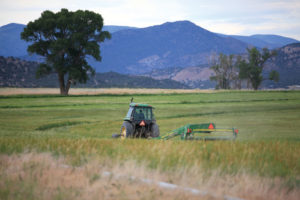By John Mattingly
It’s been a year or so since Renewable Water Resources (RWR) went public with a plan to export San Luis Valley groundwater to the “great and growing cities” on the Front Range. So far, there have been meetings and discussions and opinions but no actual filing by RWR with the district water court.
The pause is not surprising. Water projects take time, measured in decades rather than years. A project might start with certain assumptions and goals, only to change in reaction to input and actions from both citizens and government. Of special note, the current Republican administration has taken action in various agencies to reduce permitting and compliance requirements for pipelines and other large infrastructure projects, a leniency that could change after the presidential election.
While the RWR project appears to be in a slow spot, the inglorious work of building an administrative framework to restore, sustain, and manage Valley aquifers to the levels measured from 1978 to 2000, proceeds at a similarly glacial pace. Each water basin in the Valley is managed, in part, by a subdistrict of the Rio Grande Water Conservation District (RGWCD).
Each subdistrict has a board of managers, comprised of qualifying citizens, responsible for a water management plan that will meet sustainability requirements, replace injurious depletions, operate a water budget, and assess water users. If the subdistrict effort fails, the state of Colorado could curtail pumping until the aquifer is restored to the levels mandated by law.
This puts measurable pressure on the citizens who serve on the various subdistrict boards to get it right. Failure would mean that Valley irrigators and citizens did to themselves what only the most rapacious of water exporters could do: deplete the groundwater to the point that the state has to come in with command and control measures.
Last fall, citing a conflict of interest, the RGWCD removed Jerry Berry from the board of managers representing the San Luis Valley RGWCD Subdistrict #4, responsible for restoring sustainability to aquifers in the San Luis Creek basin, also known generally as Water District 25 in the State’s basin designations, and more recently as RGWCD Subdistrict #4.
Berry manages several large farms and ranches within the Subdistrict #4 boundaries. Following nomination to the board of managers at formation of the Subdistrict several years ago, Berry was elected by the other managers as board president. The position required a commitment of time to meetings and tedious deliberation without compensation.
Few farmers and ranchers in the north end of the Valley are universally loved, but whatever else is true of Mr. Berry, he is a good farmer, and his skills extend to economies of scale, as he manages operations that account for a substantial percentage of the water users in Subdistrict #4.
In addition to managing farms and ranches, Berry has a financial interest in Renewable Water Resources (RWR), and this interest represented a potential conflict with the conservation interests of the RGWCD, whose board had a stated policy of opposition to the RWR plan to export 22,000 acre-feet of SLV groundwater to the Front Range.
Water export plans – like the one currently incubating as designs and dreams of RWR – are subject to special scorn among some in the Valley, whose activists did their part to beat back American Water Development Inc. (AWDI) and Stockmans Water Company (SWC) in the past.
The RWR story is similar to those of AWDI and SWC, in that all three entities pointed out that selling Valley water to Trans-Mountain Diversion (TMD) projects brings prosperity to all, and that claim (distribution issues aside) is true, largely because TMD water, as “new water” to the Front Range (also known as “foreign water”), can be used and reused to extinction.
“Extinction” in this context is a term of art meaning that the foreign water falls under a separate administrative regime, essentially outside the priority system, because TMD water, by definition, cannot cause injury to existing water rights in the recipient basin because it increases, rather than re-distributes, the total water supply.
Accordingly, return flows from the foreign water from a TMD, if controlled and moved into a municipal or industrial water supply system, can be recaptured, treated, and reused or sold downstream until it is fully consumed by users. Typically, the return flows from municipal water systems such as those for Front Range cities and towns are about 90 percent. Only about 10 percent is consumed with each cycle of passage through the municipal system, so the inclusion of foreign water is like turning water into wine: a single acre-foot can result in as much as ten acre-feet of consumptive use, making that TMD acre- foot worth as much as ten times its value when applied to growing crops, which is one way that water currently leaves the Valley in spuds, vegetables, grains and alfalfa).
The claim from water export entities that there is a lot of money to go around has merit. Everyone knows that “water flows uphill toward money,” but sometimes that expression fails to capture the magnitude of the magnetism. There are several variables involved with the RWR plan, but allowing some speculative indulgence, the RWR plan to export 22,000 acre-feet to the Front Range annually could, through reuse of those 22,000 acre-feet to extinction, amplify to as much as 220,000 acre-feet of wet water to Front Range cities at a retail value close to $10,000 an acre-foot, or $220 million annually.
Getting the water to the Front Range incurs costs of construction, carriage, exchange and treatment, plus repairs and maintenance, together with legal and administrative costs, but having an annual cash flow of a couple hundred million dollars relieves a lot of pressure on the bottom line.
An export project would likely create a few good paying jobs in the Valley, but there is no assurance that the farmers or ranchers who sold their water would keep the money active in the Valley. RWR has proposed a stimulus package for Saguache County of $50 million, but so far, it appears that this offer caused more bickering than good will among potential recipients bent on endorsing themselves for the biggest piece of the stimulus.
Those antagonistic to the prospect of exporting SLV water to the Front Range point out that once trans-mountain diversions start – no matter how small at first – they will proceed unabated until, at a minimum, the agricultural nature of the Valley is diminished along with all the support industries, or, at a maximum, the Valley becomes a desert. This concern also has merit.
As Subdistrict #4 president, Berry had the potential to influence the conservation and sustainability interests of the State and the RGWCD, and also influence his own interests as a farmer and businessman in the Valley. Such conflicts of interest are common in water organizations. Everyone on a board of managers for a water organization is likely to have a conflict at some point in their service.
Once the conflict is acknowledged, it can be mitigated through accountability, transparency or recusal. Removal from office is an extreme measure: as we saw when a conflict of interest case came to light at the highest levels of U.S. government. The ruling by our U.S. Senate was that as long as a public official has some level of the public interest at heart when making a decision, it’s okay to simultaneously pursue a personal interest.
Even allowing that Trump’s acquittal expanded the acceptability of advancing personal interests from a public position, there is no indication that Berry was using his public position to advance his own, or RWR’s interests, beyond the suggestion that the RWR project might benefit both farmers and municipalities. Given that RWR has yet to file with the water court, there is no actual basis for a conflict by anyone, and there is no certainty that the RWR plan will be the start of an irreversible degradation of Valley aquifers. Until the RWR plan is actually filed and scrutinized, the benefit-to-liability ratio of the plan remains an open question.
Much of the antagonism toward water export plans comes from people who have a job administering, defending, preserving, or overseeing water, but not actually diverting it to make a living. These folks are needed, and there is nothing wrong with them wanting Valley water to stay home, but they also have a conflict of interest: by advocating for policies that limit a farmer’s options to sell water, they support the cheap food policies of this country that have kept many farmers in a position where they can make a living from farming, but must sell some of their assets in later life to cover medical expenses, pass something along to their kids, or enjoy some level of comfort in their final years.
A man who loves to farm and is good at it, and also has an interest in a water export project, is the sort of person needed in the tedious process of resolving the larger conflict between competing uses of Valley water resources, which boils down to sustaining both water and financial resources. It’s more than a matter of keeping enemies close, it’s a matter of including people in the process of resource allocation who have actually worked with the resource for their livelihood.
There’s no question that pressure on Colorado’s water resources will be tested and strained into the future. The underlying conflict, shared by Berry and the RGWCD, is that irrigated farming usually doesn’t pay until part of the capital formation of the farm is sold, and most Valley farmers (including, I suspect, Mr. Berry) would prefer that irrigated farmland and crops become the highest bidder for water rather than municipal and industrial users along the Front Range.
Next month: Can the Valley have its water and drink it too?



